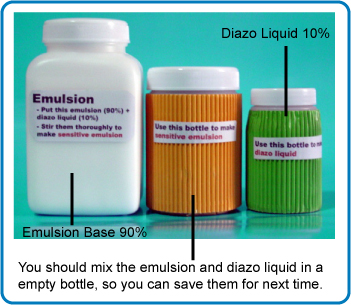

Photo emulsion screen printing can be tricky and if you still need help trying to find out which is right for you take our emulsion quiz. Exposure Time: Extremely Fast with LED exposure unit.Resistance: Solvent Resistant - No emulsion hardener is needed.We do not recommend this photo emulsion with a weak light source/DIY unit or an exposure unit that uses black light. Our photo emulsion works great with most exposure units. Ecotex® Emulsion is a pre-sensitized photo emulsion that works with UV and plastisol ink systems. Important to note: Do not use with a weak light source or blacklightsĮcotex® AP Blue Emulsion by Screen Print Direct ® is an all-purpose ready-to-use photo emulsion that holds excellent detail.Endures long print runs without breaking down.Produces crisp detailed stencils on all mesh counts.Compatible with multiple ink systems - Plastisol, UV & Solvents.Ready to use - No diazo or mixing required.Here at Camputee Press, we specialize in the screen printing technique.

The more you print the less it costs per garment! Screen printing is more cost effective for larger batches. Screen printing is a more labor intensive process and a skilled craft that when done right produces beautiful, vibrant, and durable results. DTG is good for small runs and / or very elaborate designs with many of colors. It takes a digital image and transfers it directly to your garment. Digital or Direct to Garment (DTG) works a lot like an inkjet printer. It depends on the specifics of your project, it depends. The garment is then put through a dryer to “cure” the ink. The screens are mounted on the press, the ink is placed on top of the screen and pulled through the mesh with a squeegee onto the garment.

Once the screens are burned and the ink is mixed, the printing process can begin. Each ink color requires a it’s own screen to be burned. The areas protected from the light remain water-soluble and can be washed away. The areas of the screen exposed to light make the emulsion solid bind to the screen. The screen is first coated in photo emulsion, a “negative” of the artwork is placed on the screen and then the screen is exposed the light. Lower mesh counts are used for shimmer and glitter inks while higher mesh counts are good for details and give the prints a “softer” hand touch.Įxposing or “burning the screen” is a term used for the process of creating a stencil on the screen. There are different mesh counts for different kinds of prints. For the mesh to be effective, it must be mounted on a frame and it must be under tension. Screen printing starts with screen made of a piece of mesh stretched over a frame. Originally manufactured to print logos and team information on bowling garments, but soon the new fad of printing on T-shirts began to take off. The commercialization of screen printing on garments as we know it today came with the advent of the rotatable multicolor garment screen printing machine in 1960. The iconic Marilyn Diptych being one of his most noted works. While the history of screen printing is centuries old, Artist Andy Warhol is credited with popularizing screen printing as a mainstay of pop culture. These innovations would revolutionize the commercial screen printing industry. By WWII, examples of screen printing could be seen on advertisement posters, military tanks, and t-shirts.

Printers also discovered it was possible to create multi-colored images. In the early 20th century, printers began using photo-emulsions to create stencils on screens and squeegees were introduced to pull the ink through the mesh. Stiff brushes were still being used as a way to push ink through the mesh. However, it did not gain large acceptance until silk mesh was available for trade from the east. Some time in the late 18th century, screen printing was introduced to Western Europe from Asia. The stencils were from paper and the mesh was woven from human hair stiff brushes were used to force ink through the mesh onto the fabric. Other countries like Japan adapted new methods using simple stenciling techniques. The history of screen printing originated in China during the Song Dynasty (960 – 1279 AD).


 0 kommentar(er)
0 kommentar(er)
